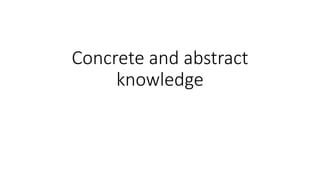
Concrete and Abstract Knowledge
- 2. • Concrete Knowledge • Concrete knowledge is as the name suggests. It involves only those things, which are visible to the human eye and are obvious to anybody looking at them. Concrete knowledge is empirical knowledge gained by one’s own experience and observation. Sensory organs are the gateway of knowledge, with the help of which a child perceives by seeing, smelling, hearing, and touching. Such knowledge is called concrete knowledge. • Philosophers opine that concrete knowledge is direct experience and is neither intuitive-experience nor probability. • There are two types of concrete knowledge • 1. Worldly concrete knowledge (Subjective) • 2. Non-worldly concrete knowledge (Objective)
- 3. • Worldly concrete knowledge is direct knowledge based on the perceptions of the sensory organs. • Non-worldly concrete knowledge- When we look concretely at objects, something related to those objects comes to our mind. • For example, when we look at a monkey, the behaviour of the monkey comes to our mind. Concrete knowledge only considers and emphasises the apparent meaning of something; it involves only those events and words, which have objective value and can be recorded and perceived. • Characteristics of Concrete Knowledge • • Concrete knowledge helps to understand the natural status of an object; • • It is based on concrete experience;
- 4. • • It does not have depth, and just refers to thinking in the periphery; and • • It is static and the same all the time. • In a classroom situation, while explaining fundamental facts to students, teachers should provide concrete knowledge. Otherwise, that knowledge does not remain for long and will not facilitate further knowledge. Teachers while providing concrete knowledge should bring natural objects/things to the classroom to give empirical knowledge/sensory knowledge.
- 5. • Abstract Knowledge • Abstract knowledge can be explained as the manner of thinking, and its concentration is on conceptualisation or generalisation. Abstract knowledge involves the much deeper, wider, and multitude of meanings of a single concept or idea, which can arouse other issues that were never seen or discussed before. • A normal person’s abstract thinking may be vague and / or incompletebecause abstract thinking goes beyond all visible things and depicts hidden thoughts about meanings and underlying implications of the existing things in nature. An abstract thinker can view a particular phenomenon from an angle that others might not be able to view.Religion and religious books of different countries depict this kind of knowledge. This belief itself is abstract knowledge. Here, belief is an important factor. This knowledge cannot be certified or rejected.
- 6. • Characteristics of Abstract Knowledge • • It is based on logical thinking; • • It has a variety of perspectives; • • It is based on people’s beliefs; • • It is a process of extracting the underlying meaning of concept; • • It is based on abstract thinking; • • It can be upgraded through research and experimentation; • • It cannot be verified; and • • It gives attention to hidden meanings. • Apart from these characteristics, we can also see some differences between concrete and abstract knowledge.
- 7. Concrete knowledge Abstract knowledge 1) Always objective, to the point, and very direct, allowing any individualto observe and understand 2) No depth, just refers to objective reality 3) Can be directly experienced 4) Sensory based experience 5) It is specific, tangible 6) Based on what the person sees as well as facts related to concept 7) Probabilities are less 1) Pays attention to hidden meaning 2) Goes beneath the surface 3) Mental processing is involved 4) Refers to figurative description 5) It is unclear, obscure 6) Based on ideas and beliefs 7) Probabilities are more